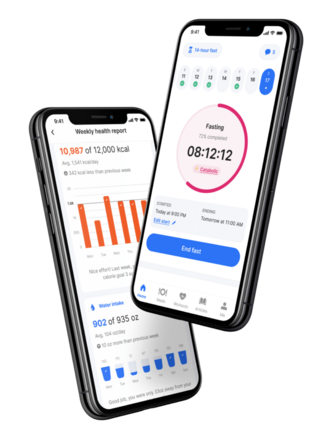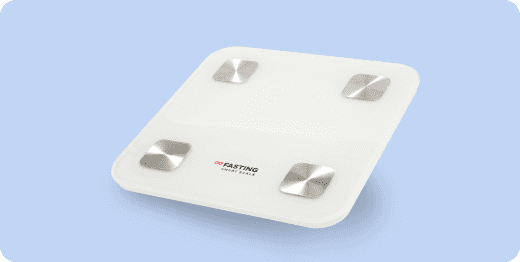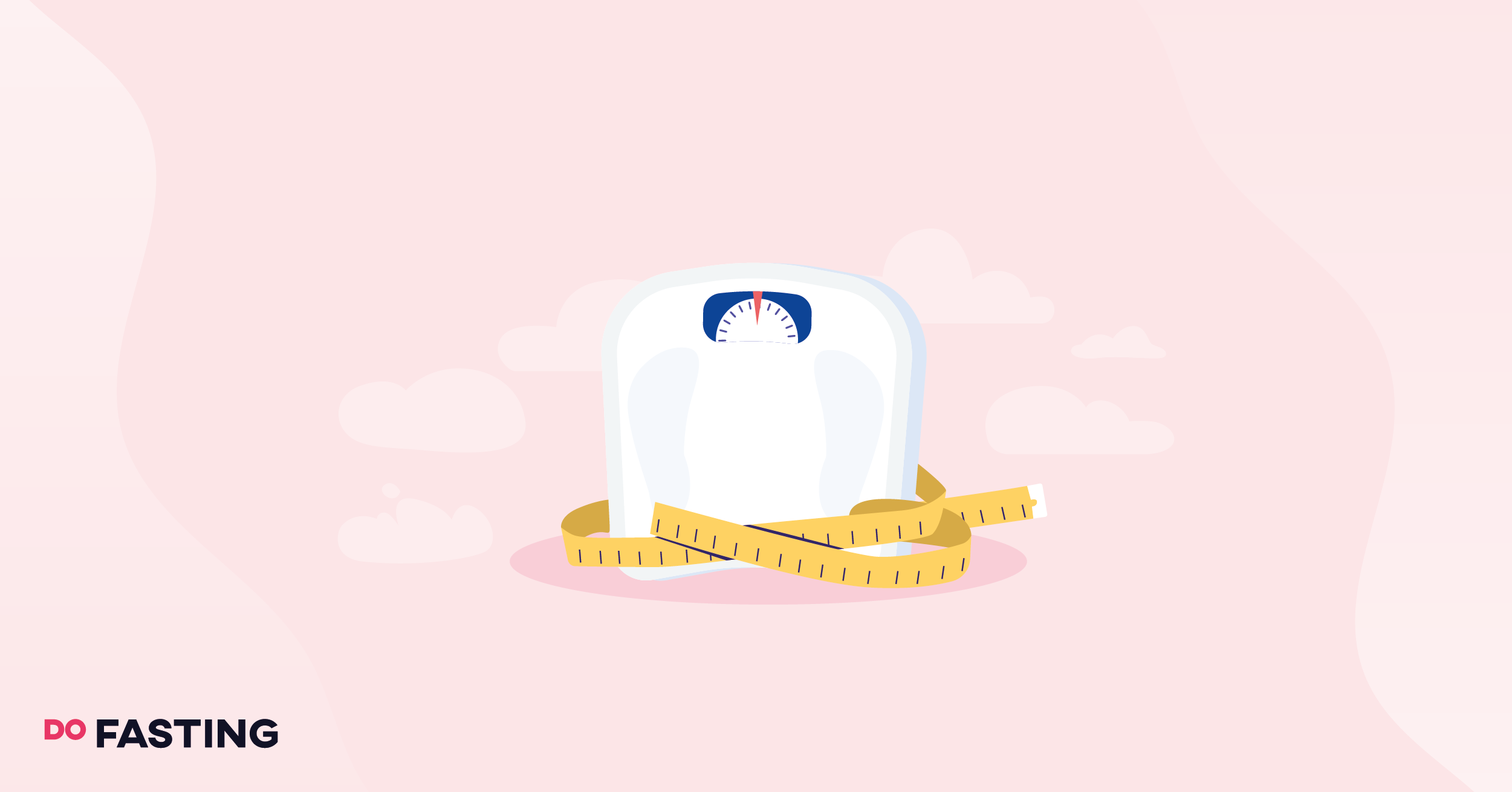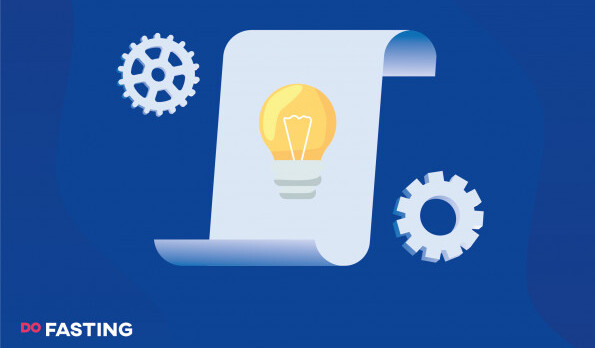Contents
Why Intermittent Fasting for Weight Loss?
To begin with, let’s go over what exactly intermittent fasting means and what practices it involves. And just to get it out of the way, we can clear up some misunderstandings that many people have about the practice of intermittent fasting.
This type of diet is not about having you skip breakfast and feel hungry all day. It’s not a “fast” diet or one that punishes you based on what type of food you eat.
Instead, unlike other diets, implementing fasting periods into your day will help with natural, healthy weight loss and many other medically-proven benefits with scientific evidence, including heart health, aging, cancer, and diabetes.
Intermittent fasting, at its core, is not about what you eat, but when you eat. This important distinction separates fasting from any other diet. And rather than continuous calorie restriction, intermittent fasting relies on time-restricted eating and healthy foods.
But what makes fasting work? You might have heard of “ketosis” before, from such diets as low-carb or keto. And while those diets might leave you feeling hungry and tired, achieving ketosis is manageable and sustainable with intermittent fasting.
Fasting works by using purposeful and timed calorie restriction, during which your body can tap into its fat-burning potential instead of using stored sugar, which is known as “metabolic switching”, or ketosis.
Once your body stops burning sugar and starts using fat reserves, you will notice health benefits and weight loss.
Plus, longer periods spent in ketosis will transform your body into viewing fat cells as its primary fuel source, instead of the glucose left behind by normal, high-carb diets.
That’s where the DoFasting app and our specialist programs come in.
You start your personalized intermittent fasting program for fat loss, healthier blood sugar levels, and a better diet for the long term, and monitor your progress daily. It’s a great way to get started on a weight loss journey.
Take a
1-minute quiz
and discover how much weight you can lose with DoFasting!

How To Start Intermittent Fasting for Weight Loss?
First of all, let’s address some of the common myths about intermittent fasting. As we have seen, you can eat breakfast and are not restricted to a liquid diet. Your health and wellness depend on healthy food consumption, just fewer calories.
Additionally, fasting is not an immediate cure to obesity or health issues— it’s a way of life that helps foster healthy habits, as well as a better mind and body.
But how long until you see the most results? Everyone’s body is different and so their weight loss journey will also be unique to them, so it depends.
You need to fast for long enough to kickstart the 5 stages of fasting which lead to losing weight. However, that doesn’t mean you need to fast for days at a time! Instead, choose a program that is right for you, and the results will come naturally.
The key to smashing your weight loss and health goals lies in choosing the best intermittent fasting plan for weight loss. But don’t worry — these fasting options are easy to understand, so let’s break them down.
Time-Restricted Eating
While this style of fasting can be further broken down into individual categories that refer to certain timeframes of feeding and fasting, which we will discuss in just a moment, they all fall under the purview of time-restricted eating.
By restricting your food intake based on timing or schedule, you consume your daily amount of calories in a certain portion of the day. This time period can be altered, so time-restricted eating is a very flexible choice, especially with the following options.
14:10
When adopting this plan, your day will involve 14 hours of fasting, and then 10 hours in which you can eat your daily allowance of calories. The 14:10 fasting plan is achievable for most people, as it gives you a large window to eat within.
You can even eat breakfast if you start your 10 hours of calorie intake at 9 a.m.!
16:8
Also known as the Leangains diet, this plan requires 16 hours to restrict calories and 8 hours to feed yourself. The Leangains diet also adds an exercise plan into the mix, with a focus on weight training for muscle mass and fat burning.
24-Hours Fast
Otherwise called the OMAD method, which stands for “one meal a day”, it just might be the most challenging fast.
This hardcore version of fasting requires you to refrain from caloric intake for most of an entire 24-hour cycle, ie. from breakfast to breakfast, before eating one healthy, balanced meal.
It’s one of the most intensive forms of intermittent fasting, and is not recommended for everyone — but it can be highly effective in getting the results you want, swiftly.
Warrior Diet
The Warrior Diet is another intense method of fasting for quick results. In essence, this plan is a 20-hour fast that allows you small portions of specific lean, solid foods at the end of the day, while also encouraging a workout session around dinnertime.
This is another difficult plan to follow, but users of the Warrior Diet can see results in a short time when sticking to it.
The 5:2 Method
Stepping away from the previous forms of time-restricted eating, let’s talk about one of the easiest ways to implement a type of intermittent fasting into your life.
By using this method, you have 5 days to eat normally before restricting caloric intake to 500-600 per day for the remaining 2 days in a given week.
Eat Stop Eat
It might sound simple, but the Eat Stop Eat method does take some planning. By interrupting your normal diet with a 24-hour fast one or two times per week, you can gain a calorie deficit that promotes a fat-burning metabolism fairly easily.
Alternate-Day Fasting (ADF)
By using alternate-day fasting, you can safely and quickly see results while still remaining fairly comfortable. In general, you will alternate days of eating normally and fasting, with a maximum of 500 calories for a fasting day’s intake.
How Long Should You Fast to Lose Weight?
So, how long do you need to follow a plan and how much weight can you lose with intermittent fasting? It’s a common question, and answers will vary.
By using the more intensive options such as the warrior diet which we covered above, results are faster than the 14:10 method, for example. It depends on your deficit and exercise regime, your own body, and stress levels.
In general, people can experience weight loss between one week and ten weeks into the DoFasting program, depending on the plan and how well you stick to it.
And the results from intermittent fasting can range from a couple of pounds to over twenty, as seen by some of our users. The trick lies in restricting calories and exercising.
Take a
1-minute quiz
and discover how much weight you can lose with DoFasting!

3 Benefits When Doing Intermittent Fasting for Weight Loss
Now, let’s take a minute to talk about some of the advantages that many people who follow an intermittent fasting plan experience.
Does fasting help lose weight? Yes, it does! It’s indisputable that fasting with an eating window does help you shed pounds, but there are many more benefits of a fasting period.
Lowering your calorie intake and tapping into ketone-based energy slows down the aging process, gives clear benefits to your skin, reduces inflammation, and helps your brain and heart health.
You can also improve metabolic health and achieve a better body mass index, all while maintaining muscle mass. Read on for more great benefits that you can expect from our fasting plans.
-
Spending Less Money on Groceries
Fasting still involves eating, of course, but because you are dedicating specific times to meal skipping and others to eating healthy foods, you’ll need fewer groceries, in turn saving more money.
Even with an alternate-day fasting plan, though you will have non-fasting days, the costs associated with junk food or takeaways will be reduced drastically because of your new healthy diet routine.
Whole grains, lean protein, and vegetables will become your regular diet, instead of packaged food that is costly not only for your wallet but your health too.
-
Forming a Better Relationship With Healthy Food
Speaking of a better diet, by relying on intermittent fasting plans, you can achieve a healthy relationship with the right kinds of food. Calorie restriction is only the first part of getting to your goals — the other part is about maintaining them and this new, healthier way of life.
-
Losing Belly Fat and Inches From the Waistline
And finally, the main reason that many people approach a fasting diet program: as a way to lose weight.
You can fast to lose belly fat by implementing healthy calorie restrictions into your diet, and by transforming your body into a metabolic machine that burns fat stores. Then, you can target common problem areas such as the waistline, belly, and hips.
Intermittent Fasting Weight Loss Success Stories
Fasting is successful for many reasons, including being effective for weight loss. But don’t just take it from us — let’s take a look at actual DoFasting app success stories.
Krystal’s Story
Krystal used the DoFasting app and lifestyle challenge to change her life entirely. She lost weight and became a healthier person— within only four weeks, she shed 16 lbs and was feeling better than ever.
Sandra’s Story
For Sandra, her success centered around changing her eating habits and adopting a better lifestyle, something that awarded her 32 lbs in weight loss!
She combined DoFasting plans with intensive weekly workouts right on the app itself to kickstart her results, and she’s not looking back.
Betsy’s Story
Betsy’s DoFasting journey took a whole year, but she stuck to her goals and was able to achieve a fantastic 53 lbs in weight loss. By narrowing her eating window, Betsy saw big results quite quickly.
Annie’s Story
With DoFasting, Annie was able to drop 21 lbs in just 5 weeks – not only does her mind feel clearer and her body feel healthier, but she’s much happier!
Is Intermittent Fasting for Everyone?
Lastly, you might be wondering— is this type of fasting to lose weight safe for everyone? The answer depends on lifestyle and pre-existing health conditions.
Intermittent fasting might not be right for you if the following apply, and you should consult a healthcare professional before trying fasting:
- Breastfeeding
- Pregnant
- Chronic Illness
- Diabetic
- Heart Disease
- High Blood Pressure
- Insomniac
- People with a history of eating disorders
- Taking certain medications
- Under 18
Take a
1-minute quiz
and discover how much weight you can lose with DoFasting!

Conclusion
So, we have gone over the basics of what intermittent fasting entails, the variety of plans available, and some awesome weight loss and overall health success stories using the DoFasting app. Now it’s time for you to join the fasting tribe!
And with DoFasting, there are many ways to tailor eating periods to your personal preferences, lifestyle, and schedule, so you don’t have to worry about a one-size-fits-all approach.
Determine the fasting type that works for you, log your health milestones, and keep updated on your weight loss progress.
See how DoFasting will improve your life
Find out what works for you with this 60-sec quiz approved by our experts and get your personal revolutionary fasting assistant.
Start the Quiz














